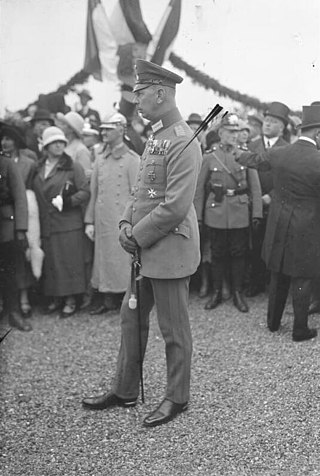This article needs additional citations for verification .(April 2022) |
| |||||
| Decades: | |||||
|---|---|---|---|---|---|
| See also: | Other events of 1934 History of Germany • Timeline • Years | ||||
Events in the year 1934 in Germany .
This article needs additional citations for verification .(April 2022) |
| |||||
| Decades: | |||||
|---|---|---|---|---|---|
| See also: | Other events of 1934 History of Germany • Timeline • Years | ||||
Events in the year 1934 in Germany .
Head of State

Paul Ludwig Hans Anton von Beneckendorff und von Hindenburg was a German field marshal and statesman who led the Imperial German Army during World War I. He later became president of Germany from 1925 until his death. During his presidency, he played a key role in the Nazi seizure of power in January 1933 when, under pressure from his advisers, he appointed Adolf Hitler as chancellor of Germany.

The Night of the Long Knives, or the Röhm purge or Röhm Coup, also called Operation Hummingbird, was a purge that took place in Nazi Germany from 30 June to 2 July 1934. Chancellor Adolf Hitler, urged on by Hermann Göring and Heinrich Himmler, ordered a series of political extrajudicial executions intended to consolidate his power and alleviate the concerns of the German military about the role of Ernst Röhm and the Sturmabteilung (SA), the Nazis' paramilitary organization, known colloquially as "Brownshirts". Nazi propaganda presented the murders as a preventive measure against an alleged imminent coup by the SA under Röhm – the so-called Röhm Putsch.

Ernst Julius Günther Röhm was a German military officer and a leading member of the Nazi Party. A close friend and early ally of Adolf Hitler, Röhm was the co-founder and leader of the Sturmabteilung (SA), the Nazi Party's original paramilitary wing, which played a significant role in Adolf Hitler's rise to power. He served as chief of the SA from 1931 until his murder in 1934 during the Night of the Long Knives.
Führer is a German word meaning "leader" or "guide". As a political title, it is strongly associated with Adolf Hitler, the dictator of Nazi Germany from 1933 to 1945. Hitler officially styled himself der Führer und Reichskanzler after the death of President Paul von Hindenburg in 1934 and the subsequent merging of the offices of Reichspräsident and Reichskanzler.

Kurt Ferdinand Friedrich Hermann von Schleicher was a German general and the penultimate chancellor of Germany during the Weimar Republic. A rival for power with Adolf Hitler, Schleicher was murdered by Hitler's SS during the Night of the Long Knives in 1934.
Generalfeldmarschall was a rank in the armies of several German states and the Holy Roman Empire (Reichsgeneralfeldmarschall); in the Habsburg monarchy, the Austrian Empire and Austria-Hungary, the rank Feldmarschall was used. The rank was the equivalent to Großadmiral in the Kaiserliche Marine and Kriegsmarine, a five-star rank, comparable to OF-10 in today's NATO naval forces.
The early timeline of Nazism begins with its origins and continues until Hitler's rise to power.

The Hitler cabinet was the government of Nazi Germany between 30 January 1933 and 30 April 1945 upon the appointment of Adolf Hitler as Chancellor of the German Reich by President Paul von Hindenburg. It was contrived by the national conservative politician Franz von Papen, who reserved the office of the Vice-Chancellor for himself. Originally, Hitler's first cabinet was called the Reich Cabinet of National Salvation, which was a coalition of the Nazi Party (NSDAP) and the national conservative German National People's Party (DNVP). The formation of a Nazi dominated government marked the beginning of Hitler's dictatorship, which lasted until his suicide during the defeat of Nazi Germany. Hitler's cabinet was succeeded by the short-lived Goebbels cabinet, with Karl Dönitz appointed by Hitler as the new Reichspräsident.

The flag of Nazi Germany, officially the flag of the German Reich, featured a red background with a black swastika on a white disc. This flag came into use initially as the banner of the Nazi Party (NSDAP) after its foundation. Following the appointment of Adolf Hitler as Chancellor in 1933, this flag was adopted as one of the nation's dual national flags, the other being the black-white-red triband of the German Empire.

Otto Lebrecht Eduard Daniel Meissner was head of the Office of the President of Germany from 1920 to 1945 during nearly the entire period of the Weimar Republic under Friedrich Ebert and Paul von Hindenburg and, finally, under the Nazi government under Adolf Hitler.

Oskar Wilhelm Robert Paul Ludwig Hellmuth von Beneckendorff und von Hindenburg was a German Generalleutnant. The son and aide-de-camp to Generalfeldmarschall and Reich President Paul von Hindenburg had considerable influence on the appointment of Adolf Hitler as German chancellor in January 1933.

Adolf Hitler's rise to power began in the newly established Weimar Republic in September 1919 when Hitler joined the Deutsche Arbeiterpartei. He rose to a place of prominence in the early years of the party. Being one of its most popular speakers, he was made the party leader after he threatened to otherwise leave.

Carl Fedor Eduard Herbert von Bose was head of the press division of the Vice Chancellery (Reichsvizekanzlei) in Germany under Vice Chancellor Franz von Papen. A conservative opponent of the Nazi regime, Bose was murdered during the Night of the Long Knives in the summer of 1934.

The government of Nazi Germany was a totalitarian dictatorship governed by Adolf Hitler and the Nazi Party(National Socialist German Workers' Party)according to the Führerprinzip. Nazi Germany was established in January 1933 with the appointment of Adolf Hitler as Chancellor of Germany, followed by suspension of basic rights with the Reichstag Fire Decree and the Enabling Act which gave Hitler's regime the power to pass and enforce laws without the involvement of the Reichstag or German president, and de facto ended with Germany's surrender in World War II on 8 May 1945 and de jure ended with the Berlin Declaration on 5 June 1945.
The Industrielleneingabe was a petition signed by 19 representatives of industry, finance, and agriculture on November 19, 1932 that requested for German President Paul von Hindenburg to make Adolf Hitler the German Chancellor.

The July Putsch was a failed coup attempt against the Austrofascist regime by Austrian Nazis from 25 to 30 July 1934.
Events in the year 1937 in Germany.

Erich Mühsam was a German antimilitarist anarchist essayist, poet and playwright. He emerged at the end of World War I as one of the leading agitators for a federated Bavarian Soviet Republic, for which he served five years in prison.
The following events occurred in August 1934:
The Law Concerning the Head of State of the German Reich was a statute enacted by the government of Nazi Germany on 1 August 1934 that consolidated the positions of Reich President and Reich Chancellor in the person of Adolf Hitler.